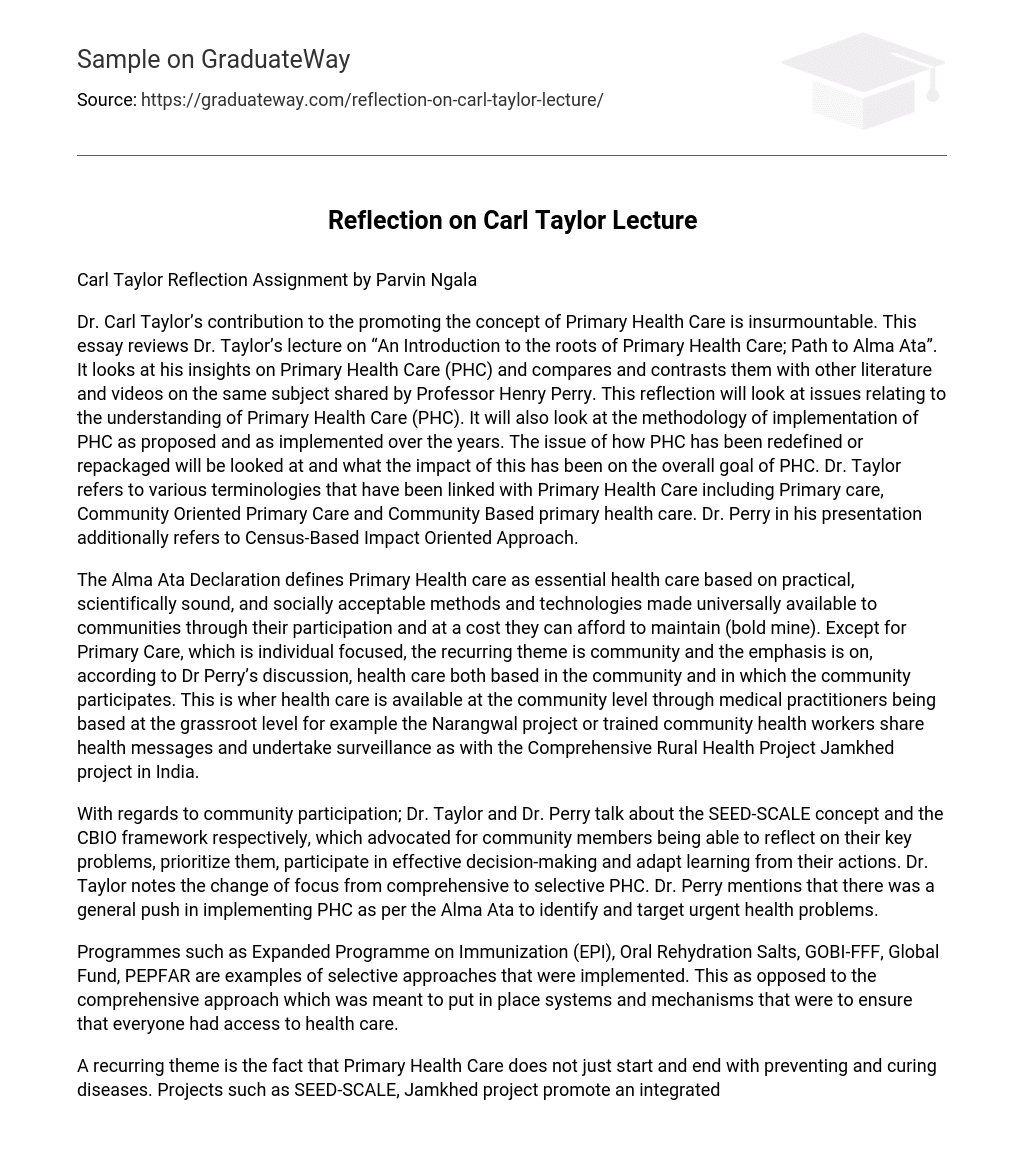Dr. Carl Taylor’s contribution to the promoting the concept of Primary Health Care is insurmountable. This essay reviews Dr. Taylor’s lecture on “An Introduction to the roots of Primary Health Care; Path to Alma Ata”. It looks at his insights on Primary Health Care (PHC) and compares and contrasts them with other literature and videos on the same subject shared by Professor Henry Perry. This reflection will look at issues relating to the understanding of Primary Health Care (PHC). It will also look at the methodology of implementation of PHC as proposed and as implemented over the years.
The issue of how PHC has been redefined or repackaged will be looked at and what the impact of this has been on the overall goal of PHC. Dr. Taylor refers to various terminologies that have been linked with Primary Health Care including Primary care, Community Oriented Primary Care and Community Based primary health care. Dr. Perry in his presentation additionally refers to Census-Based Impact Oriented Approach.
The Alma Ata Declaration defines Primary Health care as essential health care based on practical, scientifically sound, and socially acceptable methods and technologies made universally available to communities through their participation and at a cost they can afford to maintain (bold mine).
Except for Primary Care, which is individual focused, the recurring theme is community and the emphasis is on, according to Dr Perry’s discussion, health care both based in the community and in which the community participates. This is wher health care is available at the community level through medical practitioners being based at the grassroot level for example the Narangwal project or trained community health workers share health messages and undertake surveillance as with the Comprehensive Rural Health Project Jamkhed project in India.
With regards to community participation; Dr. Taylor and Dr. Perry talk about the SEED-SCALE concept and the CBIO framework respectively, which advocated for community members being able to reflect on their key problems, prioritize them, participate in effective decision-making and adapt learning from their actions. Dr. Taylor notes the change of focus from comprehensive to selective PHC. Dr. Perry mentions that there was a general push in implementing PHC as per the Alma Ata to identify and target urgent health problems.
Programmes such as Expanded Programme on Immunization (EPI), Oral Rehydration Salts, GOBI-FFF, Global Fund, PEPFAR are examples of selective approaches that were implemented. This as opposed to the comprehensive approach which was meant to put in place systems and mechanisms that were to ensure that everyone had access to health care.
A recurring theme is the fact that Primary Health Care does not just start and end with preventing and curing diseases. Projects such as SEED-SCALE, Jamkhed project promote an integrated approach addressing health issues such as food supply, nutrition, water supply and maternal and child health and socio-economic issues which are often root
causes for health issues in a community. These projects have incorporated economic empowerment initiatives as part of the overall Primary Health Care programs. Another thing consistent in all the literature, is that the fact of Primary Health Care did not start with the Alma Ata declaration. Dr. Taylor provides various examples of approaches, which in a way contributed to promoting best practices to what is now defined as Primary Health Care.
These include the work by Ding Xian in training and sending health workers “the barefoot doctors” to the community and the Community Oriented Primary Care (COPC) started by Kark in South Africa and later replicated in the US and Israel. Other projects include those by Hydrick in Indonesia, Stampar in Croatia, Eloesser in Chile and China, the Narangwal and Jamkhed projects in India. Dr. Perry also mentions these examples in his presentation on the origins and evolution of PHC.
The role of various non-governmental actors is acknowledged as having been both positively and negatively significant in the PHC journey. Dr. Taylor mentions the Rockefeller foundation, which contributed to developing centers in around 15 countries including India and Sri Lanka, which served as a foundation for their formal health systems. On the other hand, Dr. Perry talks about international funding bodies such as PEPFAR, Global Fund which prefer vertical approaches of administration of health care with specific diseases being targeted.
Dr. Taylor also talks about the role of traditional practitioners and their potential role in Primary Health. While some programs have included Traditional Birth Attendants as part of their health care systems there is a much bigger scope for traditional practitioners but this is not mentioned in the literature provided. On the overall, the insights into primary health care provided by Dr. Taylor’s lecture are consistent with those from the other assigned lectures, readings and videos from the course.





